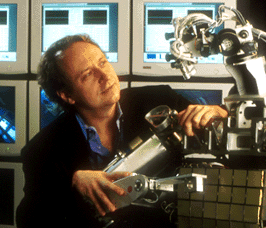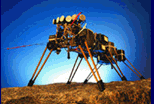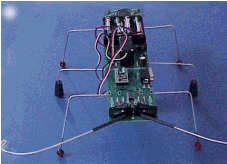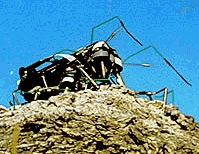|
|
|
|
|
|
Bug Robots
|
|
 |
I don't show many people on this
site, but there is no discussion of bug robots without
Rodney Brooks. He pretty much started the bug robot
idea. There is so much information online about Rodney,
his work at MIT, at iRobot and now with Baxter that
there is no reason for me to go there. I will tell you about a time I had
lunch with him in the mid-1990's just off the Stanford
University campus. I'm sure he doesn't remember. I was
in a group of ten or twenty people presenting research work
and was lucky enough to sit at the same table as
Rodney. We
talked about our kids, our wives, the weather and none
about robots. He's a nice guy; with an unassuming,
down-to-earth personality and an Australian accent. I do find it interesting
that Rodney's
robotics research has progressed from bugs, to horses,
to dogs and now on to humanoid robots. A kind of human evolution in a lifetime.
|
|
|
|
The basic idea behind the bug robots
was to try to understand very simple biologic creatures
and create corresponding robots before trying to build
highly complex robots that try to mimic human reasoning.
Even a fruit fly with less than twenty neural
connections can fly, avoid obstacles, find food and mate
(however it is that fruit flies mate). This idea makes a lot of
sense, but in practicality building very tiny robots is
quite difficult. It seems like the people who work on
bug robots spend more time developing techniques for
building tiny robots than they do on studying bug
behaviors and ways to mimic them. |

|
|
|
 |
If you want to give bug robots a try,
you might consider the little BugBrain by Yost
Engineering on the left.
Those big whiskers on the front give the bug the ability
to sense contacts with objects in its environment and
you can program the onboard computer to make decisions
about how to react. That's a true robot. You can add
other sensors to it too. Maybe a phototransistor so the
bug can "run for the shadows" like real bugs
do? According to the manufacturer you can also add
wireless RF and an ultrasonic range finder to the bug.
That could give it sensing and decision making
capabilities on-par with University research robots. |
|
|
|
The exploration of Mars is one
application that has been proposed for bug robots.
Instead of sending one or two big robots, send one or
two thousand bug robots equipped with small cameras and
chemical sensors. One of the advantages of this approach
is fault tolerance. If a few of the bugs break or get
lost, it is no big deal. Another is the ability of the
small bugs to get into small places such as cracks or
fissures in rocks. Or course the small size of the
robots also limits the scale of tasks they can
accomplish. For example even a thousand bugs working
together are not going to drill a core sample ten feet
into the Martian crust. |

|
|
|
|
|